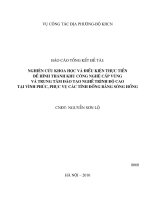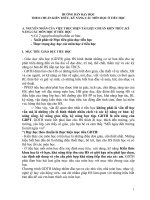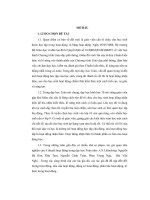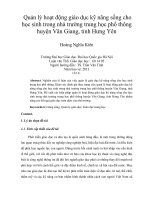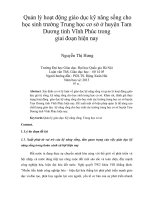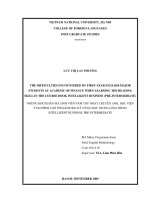kích hoạt kiến thức nền để nâng cao kĩ năng nghe cho học sinh trung học phổ thông activating prior knowledge in improving listening skills of high school students kích hoạt kiến thức nền để nâng cao kĩ năng nghe cho học sinh trung học phổ thông
Bạn đang xem bản rút gọn của tài liệu. Xem và tải ngay bản đầy đủ của tài liệu tại đây (1.44 MB, 72 trang )
VIETNAM NATIONAL UNIVERSITY, HANOI
UNIVERSITY OF LANGUAGES AND INTERNATIONAL STUDIES
FACULTY OF POST-GRADUATE STUDIES
NGUYỄN THỊ LAN
ACTIVATING PRIOR KNOWLEDGE IN
IMPROVING LISTENING SKILLS OF HIGH
SCHOOL STUDENTS
KÍCH HOẠT KIẾN THỨC NỀN ĐỂ NÂNG CAO KĨ NĂNG NGHE CHO
HỌC SINH TRUNG HỌC PHỔ THÔNG
M.A. Minor Programme Thesis
Field : English Teaching Methodology
Code : 60.14.10
Hanoi - 2013
VIETNAM NATIONAL UNIVERSITY, HANOI
UNIVERSITY OF LANGUAGES AND INTERNATIONAL STUDIES
FACULTY OF POST-GRADUATE STUDIES
NGUYỄN THỊ LAN
ACTIVATING PRIOR KNOWLEDGE IN
IMPROVING LISTENING SKILLS OF HIGH
SCHOOL STUDENTS
KÍCH HOẠT KIẾN THỨC NỀN ĐỂ NÂNG CAO KĨ NĂNG NGHE CHO
HỌC SINH TRUNG HỌC PHỔ THÔNG
M.A. Minor Programme Thesis
Field : English Teaching Methodology
Code : 60.14.10
Supervisor : Dr, Huỳnh Anh Tuấn
Hanoi – 2013
i
DECLARATION
I, hereby, certify the thesis entitled “Activating prior knowledge in
improving listening skills of high school students” is the result of my own research
for the Minor Degree of Master of Arts at the University of Language and
International Studies, Vietnam National University, Hanoi, and this thesis has not,
wholly or partially, been submitted for any degree at any other universities or
institutions.
Hanoi, 2013
NGUYEN THI LAN
ii
ACKNOWLEDGEMENTS
I would like to acknowledge my deep gratitude to all those who have
supported me in doing this independent study.
Firstly, I would like to express my greatest appreciation to my supervisor,
Dr. Huynh Anh Tuan for his valuable time and useful guidance towards the
completion of this study.
Secondly, I am extremely grateful to the staff members of the Faculty of Post
- graduate studies for their helpful lectures.
My special thanks are also sent to my lecturers, my friends, my classmates,
as well as my colleagues for their invaluable comments and criticism and also for
their continued interest and encouragements.
Thirdly, I appreciate the assistance and cooperation given to me by teachers
and students at Giao Thuy B high school. Without their sincere participation, this
paper would not have been possible.
Last but not least, I want to express my deepest gratitude to my beloved
people, my parents, my husband and my children for their love, care, tolerance and
encouragement.
iii
ABSTRACT
In recent years more and more studies have focused on language learning
strategies and their importance, especially learning strategies in listening skill.
Sharing the same concern, this research aims at providing some information relating
to the perception of activating prior knowledge in improving listening skill to high
school students. Firstly, the author briefly reviewed some literature concerning this
issue. Then data were collected by two instruments, namely questionnaires for both
students and teachers, and class observations. Nine teachers and 221 students in
grade 10 and 11 were sampled. The Microsoft Excel was undertaken to analyze the
data. The final results indicated that the teachers and students had inadequate
knowledge about the role of activating prior knowledge in listening lessons. The
study also showed the difficulties that students encounter due to lack of prior
knowledge in listening. Lastly, the study offered some implications for activating
students’ prior knowledge in teaching and learning listening skill.
iv
TABLE OF CONTENTS
Declaration ………………………… …………………………… i
Acknowledgements……………………………………… …… ii
Abstract………………………………………………… ……… iii
Table of contents…………………………………….………………… iv
List of tables and figures……………………………………………… vii
PART I: INTRODUCTION
1. Rationale…………………………………………………………… 1
2. Aims and objectives of the study………………………………… ,,, 1
3. Scope of the study………………………………………………… 2
4. Significance of the study …………………………………………… 2
5. Research methodology………………………………………………… 3
6. Design of the study……………………………………………………… ,.3
PART TWO. DEVELOPMENT
CHAPTER1.
THEORETICAL BACKGROUND AND LITERATURE REVIEW
I. THEARETICAL BACKGROUND
1.1. Theories on listening comprehension
1.1.1. The concepts of listening comprehension 5
1.1.2. The processes of listening comprehension ………………………… 6
1.2. Theories on activating prior knowledge in the pre- listening stage
1.2.1. Definitions of activating prior knowledge in the pre- listening stage……,,8
1.2.2. Roles of activating prior knowledge in the pre- listening stage …………,9
1.2.3. Activities to activate prior knowledge in the pre- listening stage 10
1.2.4. Factors affecting the choice of pre-listening activities 11
1.3. Schema
1.3.1 Definitions of schema 12
1.3.2. Characteristics of schema 13
v
1.3.3. Types of schema 13
II. LITERATURE REVIEW ………… ……………………… 14
CHAPTER 2. RESEARCH METHODOLOGY
2.1. Research questions 16
2.2. Research approach…………………………………………… 16
2.3. Data collection methods……………………………………….…… 16
2.3.1. The questionnaire for the teachers……………………………….… 17
2.3.2. The questionnaire for the students………………………….… 17
2.3.3. Classroom observation 18
2.4. Data collection procedure
2.4.1. The setting of the study 18
2.4.2. Participants’ background information……………………………….19
2.4.2.1. The teachers……………………………………………… 19
2.4.2.2. The students……………………………………………….… 19
2.4. 3. Procedure…………………………………………………… 20
2.5. Data analytical units 20
CHAPTER3. DATA ANALYSIS AND DISCUSSIONS
3.1. DATA ANALYSIS OF THE TEACHERS’ SURVEY QUESTIONAIRE AND
THEIR PERFORMANCE IN CLASSROOM OBSERVATION SHEET.
3.1. 1.The teachers’ attitudes toward the difficulties that high school students
encounter when their prior knowledge is not activated 21
3.1.2. The situation of applying the techniques of activating prior knowledge
in the pre-listening stage at Giao Thuy B High School 23
3.1.3. Teachers’ comments on the roles of activating prior knowledge in pre-
listening activities… ……………………… 26
3.2. DATA ANALYSIS OF THE STUDENTS’ SURVEY QUESTIONAIRE AND
THEIR PERFORMANCE IN CLASSROOM OBSERVATION SHEETS.
3.2.1. The students’ attitudes toward the difficulties that they encounter when
their prior knowledge is not activated 28
vi
3.2.2. The students’ attitudes toward the situation of applying the techniques of
activating prior knowledge in pre-listening stage at Giao Thuy B high
school 30
3.2.3. Students’ comments on the roles of activating prior knowledge in pre-
listening activities……………………………………………………… 33
3.3. SUMMARY………………………… …………………… 35
CHAPTER 4: FINDINGS AND RECOMMENDATIONS
4.1. BENEFITS OF ACTIVATING PRIOR KNOWLEDGE TO TEACHING
LISTENING
4.1.1 For the teachers…………………………………………… 37
4.1.2. For the students……………………………………… 37
4.2. RECOMMENDATION
4.2.1. To the curriculum designers …………… 39
4.2.2. To the teachers…………………………….… 39
4.2.2.1. Raising awareness of the role of pre listening
activities……… 40
4.2.2.2. Exploiting background knowledge… 40
4.2.2.3. Improving pre-listening activities in the
material 40
4.2.2.4. Using pre-listening activities appropriately and flexibly 41
4.2.3. To the students…………………… 43
PART THREE. CONCLUSIONS
REVIEW OF THE STUDY…………………………… 44
LIMITATIONS OF THE STUDY………………………………… 45
SUGGESTIONS FOR FURTHER RESEARCH…………… …… 45
REFERENCES……………………………………… 46
APPENDIX……………………………………………………………………………….I
vii
LIST OF TABLES AND FIGURES
Tables
Table 1: Teachers’ remarks about activities used to motivate students’ prior
knowledge in the pre listening stage (appendix 3, page V)
Table 2: Students’ attitudes toward activities teachers carry out in the pre listening
stage. (appendix 3, page V)
Figures
Figure 1: Teachers’ comments on the difficulties in activating prior knowledge in
pre-listening stage (appendix 4, page VI)
Figure 2: Teachers’ comments on the difficulties students encounter if their prior
knowledge is not activated in the pre-listening stage (appendix 4, page VI)
Figure 3: Teachers’ comments on the frequency of activating student’s prior
knowledge (appendix 4, page VII)
Figure 4: Teachers’ remarks about the problems when motivating prior knowledge
(appendix 4, page VII)
Figure 5: Teachers’ remarks about the importance of activating prior knowledge in
the pre-listening stage. (appendix4, page VIII)
Figure 6: Teachers’ remarks about the benefits of activating students’ prior
knowledge. (appendix4, page VIII)
Figure 7: Students’ opinions whether it difficult when listening to a lesson if prior
knowledge is not activated or not. (appendix4, page IX)
Figure 8: Students’ opinions about the difficulties students encounter when their
prior knowledge is not activated. (appendix4, page IX)
Figure 9: Students’ attitudes toward the currency of being motivated prior
knowledge in the pre listening stage. (appendix4, page X)
Figure 10: Students’ attitudes toward the duration of the pre listening stage for
activating prior knowledge. (appendix4, page X)
viii
Figure11. Students’ comments on the importance of activating prior knowledge in
the pre-listening stage.(appendix 4, page XI)
Figure 12: Students’ comments on the benefits of motivating prior knowledge.
(appendix4, page XI)
1
PART I. INTRODUCTION
1. Rationale
Listening comprehension is a fundamental language skill. Nunan (1988:1)
stated: “Listening is a basic skill in language teaching. Without listening skill,
learners will never learn to communicate effectively”. In many ESL and EFL
situations, listening is a big challenge for both teachers and learners in their
teaching and learning. Students of English in ESL and EFL situations have
difficulties in comprehending spoken language due to many reasons which may
range from their inadequate background knowledge, their limited reservoir of
vocabulary and grammatical structures, their lack of preparation for the task etc.
(Boyle, 1984). Foreign language learners have particular needs to be adjusted or
tuned in - the term Underwood, 1989, rather than being plunged straight into a
listening task without any orientation to it. Therefore, pre-listening activities are
crucial to good second language learning and teaching. During this critical phase of
the listening process, teachers prepare students for what they will hear and what
they are expected to do. Pre-listening activities help students make decisions about
what to listen for and, subsequently, to focus attention on meaning while listening.
Pre-listening activities have been carried out in listening lessons at Giao Thuy B
High School. However, they are quite not effective. One of the reasons is assumed
to be students’ background knowledge not being activated. Consequently, many
students understand very little of what they are supposed to listen to. As a teacher of
Giao Thuy B High School, in the hope of improving the listening skills of my
students, I have decided to do the following research entitled: “Activating prior
knowledge in improving listening skills of high school students”.
2. Aims and objectives of the study
The study aims at helping high school students improve their listening skills by
activating their prior knowledge. In order to achieve the aim, the study has to fulfill
the following objectives:
2
- investigating problems that SLL in general and high school students in
particular encounter while listening when prior knowledge is not activated in the
pre-listening stage
- exploring the process of activating prior knowledge by the teachers and
students in the pre-listening stage at Giao Thuy B High School
- finding out teachers’ and students’ comments on the role of activating prior
knowledge in the development of listening skill
- giving some suggestions for successful implementation of activating students’
background knowledge to help ease the difficulty of listening
3. Scope of the study
Various forms of support and factors have a valuable role to play in teaching
listening skills but the researcher’s particular concern in this research is activating
prior knowledge in pre- listening activities which interferes with the students’
ability to demonstrate the level of listening comprehension. More specifically, the
author concentrates on the difficulties in pre-listening activities that teachers and
students at Giao Thuy B high school have to cope with. Based on that, some
recommendations are given for teachers to improve their pre-listening activities to
activate students’ background knowledge to cope with their listening problems in
the class.
4. Significance of the study
As one of the uninvestigated issues in teaching listening for high school students in
Vietnam, the present study on activating prior knowledge in pre-listening stage will
make certain contributions to the development of listening skills among high school
students. The study is at the same time hoped to benefit teachers, educationists and
researchers of related fields.
• For the students, the results of the study will give impact to the improvement
of their listening. The student knows how to make full use of background
knowledge to become an effective listener.
3
• For English teachers, the findings of this study will give valuable and useful
information on the implementation of the teaching of listening. The study
firstly will help teachers to realize the role of pre-listening activities and
know how to adapt in different lessons.
• The educationists may base on the implementation of pre-listening stage to
make necessary changes in terms of curriculum, facilities to exploit pre-
listening activities to the full.
• The research will serve as the foundation for further related researches. Other
researchers may also take the strengths and weaknesses of the study into
account to better theirs.
5. Research methodology
In order to seek answers to the research questions, a survey research is adopted in
this research. Survey questionnaires and classroom observations are the two main
instruments to collect the data. The data from the observations are of great
assistance to ensure the validity of the information gathered from the survey
questionnaire. The observations were done through the checklists. They were made
by the researcher in concerning with teacher’s pre-listening activities and students’
involvement and attitudes towards the pre-listening activities. Finally, all data were
analyzed through coding, classifying, and recorded in the check list. Thanks to
these, the result is more reliable and helps the researcher suggest ways of activating
prior knowledge more easily.
6. Design of the study
This minor thesis consists of three parts: the introduction, the development and the
conclusion.
Part I: Introduction. This part presents the rationale, the aim and objectives of the
study, scope of the study, method of the study and design of the study.
Part II: Development. It is divided into 4 chapters:
Chapter 1: Theoretical background and literature review. This chapter discusses the
theoretical background and previous studies relevant to the study.
4
Chapter 2: Research methodology. It discusses the research questions, the approach
adopted, the methods of collecting data, the data collection procedure (timeline),
and data analysis methods.
Chapter 3: Data analysis and discussion. It shows the detailed results of the surveys
and covers a comprehensive analysis on the data collected from questionnaires and
class observations.
Chapter 4: Findings and recommendations. This part shows the findings and
suggests some techniques in activating prior knowledge
Part III: Conclusions. This part includes a review of the study, suggestions for
further research and limitations of the study.
Most of the students at Giao Thuy B High School have been learning English since
they were 6
th
grade students. That is to say they have had four years of learning
English at lower secondary school. However, their levels of English proficiency
vary from individual to individual.
5
PART II. DEVELOPMENT
CHAPTER 1
THEORETICAL BACKGROUND AND LITERATURE REVIEW
I. THEORETICAL BACKGROUND
1.1 .Theories on listening comprehension
1.1.1 The concept of listening comprehension
There are various points of view on listening comprehension.
Traditionally, listening is considered as a passive language skill alongside the
reading skill. It means that learners are almost passive in practicing listening skill in
the classroom like “tape recorder or trained parrot” (Anderson and Lynch,
1988:18). Learners just hear what they are to listen without paying sufficient
attention to the discourse such as the background knowledge of the speakers as well
as their intentions, attitude, implication and other shades of meaning, etc. This view
of listening comprehension seems to be inappropriate and inadequate because it
does not capture all the relevant features of comprehension.
Therefore, many researchers like O’Malley, Chamot and Kupper (1989), Rost
(1994) and Underwood (1989) have to come to another view in which the role of
the listeners is thought to be active, not passive anymore. Theoretically, listening is
viewed as an “active process in which individuals focus on selected aspects of aural
input, construct meaning from passages, and relate what they hear to existing
knowledge” (O’Malley, Chamot and Kupper, 1989: 418). In order to construct the
message that the speaker intends, the hearer must “actively contribute knowledge
from both linguistic and nonlinguistic sources” (Buck, 2001: 1-2). Anderson and
Lynch (1988:35) also share this point of view that the role of the successful listener
has to be thought of as an “active model builder”. The listener plays an important
part in the process, by activating various types of knowledge, and by applying what
he knows to what he hears and trying to understand what the speaker means.
In conclusion, listening comprehension has been defined in many different
ways. Nevertheless, the active role of listeners has been emphasized in every
6
definition. The effective listener actively engages in the process of comprehension,
not passively receive or record anymore.
1.1.2. The processes of listening comprehension
Schema is the guiding structure in the comprehension process. Schema is
defined by Anderson and Lynch (1988: 14) as “a mental structure, consisting of
relevant individual knowledge, memory and experience, which allow us to
incorporate what we learn into what we know”. If the incoming information is
matched with the schema, then the listeners have succeeded in comprehending the
text; if they are not compatible, either the information or the schema will be
discarded or modified. The principle of schema leads to two basic modes of
information processing: bottom-up processing and top-down processing. These two
processing intersect to develop an interactive processing. Thus, models for listening
process fall into three types: bottom-up processing, top-down processing and
interactive processing.
Bottom-up processing is activated by the new incoming data. Schema is
formed hierarchically, from the most specific at the bottom to the most general at
the top. According to this type of processing, listening is a process decoding the
sounds, from the smallest meaningful units (phonemes) to complete texts. Hence,
phonemic units are decoded and connected together to construct words, words are
connected together to construct phrases, phrases are connected to make utterances,
and utterances are connected to make a complete and meaningful text. Brown
(1990: 151) states that “Learners who have progressed to the point of being able to
use the phonological code competently have a good chance of being able to
recognize what most of the words intended by the speaker were, how they were
grouped into phrases, how they were structured into larger clauses (or sentences)
and how these related to each other”. That is to say, meaning is arrived at the last
step of the process. A chain of coming sounds trigger schema hierarchically
organized in a listener’s mind – the phonological knowledge, the morphological
knowledge, lexical and syntactical knowledge. This process is associated with the
7
listener’s linguistic knowledge. However, bottom-up process has its weak points.
Understanding a text is an interactive process between the listener’s previous
knowledge and the text. Efficient comprehension that associated the textual material
with listener’s brain does not only depend on one’s linguistic knowledge.
Top-down processing is explained as employing background knowledge in
comprehending the meaning of the message. Carrell and Eisterhold (1983: 557)
point out that in top down processing, the system makes general predictions based
on “a higher level, general schemata, and then searches the input for information to
fit into these practically satisfied, higher order schemata”. In terms of listening, the
listener actively constructs the original meaning of the speaker employing new input
as clues. In this reconstruction process, the listener employs prior knowledge of the
context and situation within which the listening occurs to understand what he/ she
hears. Context and situation involve such things as knowledge of the topic at hand,
the speaker(s) and the correlation with the situation, as well as with each other and
previous events. It is mentioned by Buck that in top down processing “the various
types of knowledge involved in understanding language are not applied in any fixed
order – they can be used in any order, or even simultaneously, and they are all
capable of interacting and influencing each other”. (Buck, 2001: 2). We must
realize if the incoming information the listener hears is unfamiliar to him, it can’t
evoke his schemata and he can only depend heavily on his linguistic knowledge in
listening comprehension. Besides, although the listener can trigger a schema, he
might not have the suitable schema expected by the speaker. Thus, only replying on
top- down processing may result in the failure of comprehension.
The interactive processing overcomes the disadvantages of bottom-up and
top-down processing to augment comprehension. However, it is now more
generally accepted that both top-down and bottom-up listening processing should be
combined to enhance listening comprehension. Complex and simultaneous
processing of background knowledge information, contextual information and
linguistic information make comprehension and interpretation become easy. If the
8
content is familiar with the listener, he will employ his background knowledge at
the same time to make predictions which will be proved by the new input. If not, he
can only depend on his linguistic knowledge, especially the lexical and syntactical
knowledge to make sense of information. Underwood (1989: 2) divides the aural
process into two stages. There are two levels of activities of the aural process:
“recognition and selection”. The first level is that the structure and relationship
between syntax and phonology of the language are recognized. At this level, the
sound goes into a sensory store called the “echoic memory”. “Echoic memory” is
just the short term memory because there is continuous arrival of new information
before the listener has opportunity to deal with it. That is why there is the following
stage which is called “selection”. In this level the listener selects what he finds most
interesting or important or comprehensible in the utterance. At this point, words or
groups of words are checked and compared with information already held in the
long term memory and the meaning is extracted from them (Underwood, 1989).
Therefore, the listener usually remembers the meaning rather than the exact word
spoken when he has to recall what has been said. The basis of listening
comprehension is the ability to recognize and select the specific details in the
discourse.
1.2. Theories on activating prior knowledge in the pre- listening stage
1.2.1. Definitions of activating prior knowledge in the pre- listening stage
Using prior knowledge is an important part of listening comprehension for
students. They relate listened word to their previous experiences to make listening
more active, helping them both understand and remember what they have listened.
Some experts believe that activating prior knowledge in the pre listening stage is the
most important aspect of the listening experience.
Rixon (1986: 63) defines activating prior knowledge in the pre- listening stage pre-
listening as “Things to do before the students hear the passage, to help them get the
out most of what they are going to hear.” It means that in this stage, the teacher has
to prepare the students to achieve the most from the passage. More specifically,
9
Underwood (1989:9) mentions pre-listening is a kind of “preparatory work” that
students should be “tuned in” or provided some relevant information so that they
know what to expect, both in general and for particular tasks. Ur (1992: 4) also
shares his view that “It would seem a good idea when presenting a listening
passage in class to give students some information about the content, situation and
speakers before they actually start listening.” When teaching pre-listening stage
teachers should use some teaching techniques to help students effectively activate
prior knowledge when listening i.e.: pre teaching vocabulary, providing background
knowledge and creating opportunities and a framework for students to continue
building background knowledge.
In conclusion, pre-listening work should be done in an as natural way as
possible and time for pre- listening activities in a listening lesson must be allocated
appropriately and should not be rushed.
1.2.2. Roles of activating prior knowledge in the pre- listening stage
There is widespread agreement that prior knowledge influences learning, and
that learners construct concepts from prior knowledge (Resnick, 1983; Glaserfeld,
1984). Activating prior knowledge in the pre- listening stage plays an important role
in a listening lesson. Buck (1995) mentions pre-listening activities can provide a
context for interpretation and can activate background knowledge. Mendelsohn
(1995: 140 ) also points out that the important role for pre-listening activities is to “
activate the students‟ existing knowledge of the topic in order for them to link what
they comprehend and to use this as a basis of their hypothesis – information,
prediction, and inference”
Brown & Yule (1983) found four clusters of factors which can affect the
difficulty of spoken language: the speaker (the number of the speakers, speech rate,
the types of accent), the listener (the role of listener, the level of response, the
interest in the subject), the content (vocabulary, grammar, information structure,
background knowledge), and support (visual aids to support the text – pictures,
diagrams, etc. It is believed in the literature that among these factors learners’
10
background knowledge and content schemata can affect the quality of listening
comprehension to a large extent. Research in reading supports the notion that
activating background knowledge and applying this knowledge to new input
greatly facilitates processing and understanding (Graves & Cook, 1980). Listening
has been considered, like reading, as an active process of interpretation that goes
beyond the simple decoding of the signal. In addition, its major purpose is the
construction of meaning (Rost, 2002) by matching what listeners hear with what
they already know, i.e. their background knowledge
According to Underwood (1989: 44), “ Pre-listening work is the „build-up‟ to the
actual listening and serves not only to assist with comprehension but also to
motivate students to want to listen”. Many students are fearful of listening, and can
be disheartened when they listen to something but they understand very little. It is
also harder to concentrate on listening if you have little interest in a topic or
situation. When listeners know the context of a text or an utterance, the process is
facilitated considerably because listeners can activate prior knowledge and make the
appropriate inferences essential to comprehending the message (Byrnes, 1984).
Therefore, teachers need to help students organize their thoughts, to activate
appropriate background knowledge for understanding and to make predictions, to
prepare for listening. This significantly reduces the burden of comprehension for
them.
In conclusion, prior knowledge comes in diverse forms. It affects how
students interpret instruction. It is active at levels ranging from perception to
conception to beliefs about learning itself. Moreover, its effects are widespread
through lay and professional population, from young children through to adults, and
from low to high ability students. Neglect of prior knowledge can result in the
audience learning something opposed to the educator's intentions, no matter how
well those intentions are executed in an exhibit, book, or lecture.
1.2.3. Activities to activate prior knowledge in the pre- listening stage
11
Activating prior knowledge in the pre- listening stage can consist of a whole
range of activities. According to a lot of ideas from Oxford’s Strategy Inventory of
Language Learning (Oxford, 1990) and other researchers, there are many kinds of
activities that teachers should apply to activate students’ prior knowledge in the pre-
listening stage:
- Predicting of the content of the listening text
- Pre- teaching new vocabulary or grammatical structures
- Using visual aids to introduce the topic of the text
- Discussing the topic of the listening passage
- Eliciting to main information that students may listen in the listening test
- Brainstorming to some possibilities or suggestions of the topic
- Previewing the listening tasks
- Using games to introduce the topic of the listening passage
Each of these activities helps to focus students’ minds on the topic by
narrowing down the things that the students expect to hear and activating relevant
prior knowledge and already known language. The pre-listening activities are not
used separately; many pre-listening activities can be used in a listening lesson to
gain best effects.
1.2.4. Factors affecting the choice of pre-listening activities
In order to gain the best result in activating prior knowledge in the pre-
listening stage of a listening lesson, the teacher should take the following factors
into account:
The time available
The material available
The ability of the class
The interests of the class
The interest of the teacher
The place in which the work is being carried out
The nature and content of the listening text
12
Underwood, (1989: 33)
The last item on the list “the nature and content of the listening text” is very
important when choosing activities. Some kind of activities are simply not
appropriate to some types of text, and in other instances, the text itself very
naturally makes one type of activity especially appropriate.
Listening texts which naturally rise to certain kind of top-down activities are
particularly useful and generally quite motivating for the students.
When the instructor designs these kinds of activities, they should also take the time
element into consideration. You cannot have a fifteen- minute activity for a passage
which will last only three minutes. Remember the pre-listening process should not
last longer than the actual listening activity. The learners' proficiency is also a factor
to consider. The activities should not be too demanding, otherwise the students will
lose their interests
1.3. Schema
1.3.1 Definitions of schema
Prior knowledge is organized in schemata (the plural form of schema):
abstract, generalized mental representations of our experience that are available to
help us understand new experiences. Schema theory has been one of the prevailing
theories in the field of language teaching in the past two decades or so. It’s rooted
in Barrett’s studies on human remembering – their past experiences. (Aron, 1986:
Carrell and Eisterhold 1983: Cook 1992: Nelson 1987). Schema is people’s general
knowledge of the world, namely one’s “pre-existing knowledge” or “background
knowledge”. The theory of how a reader or a listener makes use of his schematic
knowledge to achieve efficient comprehension during reading or listening is called
schema theory. In the pre-listening stage, the teacher organizes some warm-up
activities such as discussing questions about the related topic or the key words in
order to help students set up the new schemata and activate the previous schemata
stored in students’ minds
13
Researches have given a large number of different definitions of schema. Rumelhart
(1980) defines schemas as “building blocks of cognition” (p.34) and “skeleton
around which the situation is interpreted” (p.37). “A schema is a cognitive structure
that consists in part of the representation of some defined stimulus domain. The
schema contains general knowledge about that domain, including a specification of
the relationships among its attributes, as well as specific examples or instances of
the stimulus domain” and “the schema provides hypothesis about incoming stimuli,
which include plans for interpreting and gathering schema-related information”
(Taylor and Crocker, 1981, p.91). For Alba and Hasher (1983), schema is “general
knowledge a person possesses about a particular domain” (p.129). Brewer and
Nakamura (1984) explain that “schemas are the unconscious cognitive structures
that underlie human knowledge and skill” (p.136). Cohen et al (1993) define
schemas as “packets of information stored in memory representing general
knowledge about objects, situations, events, or actions” (p.28). Cook (1997)regards
schema as “a mental representation of a typical instance” (p.86).
1.3.2. Characteristics of schema
The following are some special features of schema according to Anderson,
(1997, p.418-419):
_ Schemata are always organized meaningfully can be added to, and, as an
individual gains experience, develop to include more variables and more specificity.
_ Each schema is embedded in other schemata and itself contains subschema.
_ Schema change moment by moment as information is received.
_ They may also be reorganized when incoming data reveals a need to restructure
the concept.
_The mental representations used during perception and comprehension, and which
evolves a result of these processes, combine to form a whole which is greater than
the sum of its parts.
1.3.3. Types of schema
14
Schemata are classified into two types: content schemata and formal schemata
(Carrell, 1983). The content schemata refer to “background information” on the
topic, provides readers with a foundation, a basis for comparison (Carrell &
Eisterhold 1983; Carrell, Pharis & Liberto 1989). Formal schema, often known as
textual schema. It relates to “knowledge about how discourse is organized with
respect to different genres, different topics, or different purposes (e.g., transactional
versus interactional), including relevant sociocultural knowledge” (Celce-Murcia
and Olshtain, 2000, p.102). It can include knowledge of different text types and
genres, and also includes the understanding that different types of texts use text
organization, language structures, vocabulary, grammar, level of formality/register
differently. Besides, Juan and Flor (2006 : 93 ) insist that “content schema are
networks of knowledge on different topics and formal schema are derived from our
knowledge of the structure of discourse is being listened to make it easier to engage
in top-down processing strategies, such as predicting and inferring”. Carrell and
Eisterhold (1988) assert that listeners lack culture-specific content schema
seriously. It is of importance that “in English listening, the content schema must be
activated for the learners to access their prior knowledge” (Lingzhu, 2003, p.9).
To sum up, schema plays an important role in text comprehension both in L1
and L2 context. For example, whether reading or listening in a first or second
language, one can assume that both native and non-native learners will understand
more of a text when they are familiar with content, formal, and linguistic schema.
II. LITERATURE REVIEW (Previous studies relevant to the study.)
There are some small research exists regarding the activities’ effectiveness in
improving learners’ performance on a listening comprehension task.
Hong (2006) studied on pre-listening techniques to motivate students at Lomonosov
upper-secondary school to improve the listening skills. The finding of her study
shown the role of the pre-listening techniques to the students motivation in listening
lesson. There still existed the differences between teachers’ and students’
preferences for activities done before listening.
15
Another research which is also related to pre-listening stage is a study on
pre-listening techniques to motivate Non-English major students to develop their
listening skills at the Faculty of Electro-Mechatronics at Phuong Dong University in
Hanoi by Le (2006). The findings of the study revealed several techniques used at
the first stage of listening lessons with the textbook “Lifelines” by Tom Hutchinson.
The students’ preferences for these techniques were also highlighted. Then, basing
on the teachers’ and the students’ comments, some suggestions to improve the
situation of teaching and learning at Phuong Dong University were made.
A research on the effects of pre - listening activities on the listening
performance of non-major 10th grade students at Nguyen Gia Thieu High School,
Hanoi by Nguyen Dieu Huyen (2010). Most of the teachers and the students are
satisfied with the pre-listening available in the textbook and a small number of them
find the pre-listening activities not various and interesting enough. However, the
study cannot cover all the factors affecting the students’ performances in listening
lessons
Besides, Berne (1995) investigated how varying pre-listening activities affect
second language listening comprehension. According to the study, comparison of
the listening comprehension of second language learners completing three different
pre listening activities after one and two exposures to a passage shows that scores
for subjects completing the question preview activity were higher than for subjects
completing the filler activity and that additional exposure improves comprehension.
In addition, Chang and Read (2006) investigated the effects of four types of
listening support on a listening test: previewing the test questions, repetition of the
input, providing background knowledge about the topic, and vocabulary instruction.
In conclusion, all the above studies are related to the pre-listening activities. I
found that they are quite general and difficult for adapting effectively in Vietnamese
schools. So in my study, I focus on the topic: “activating prior knowledge to
motivating listening skill in the pre-listening stage.”

